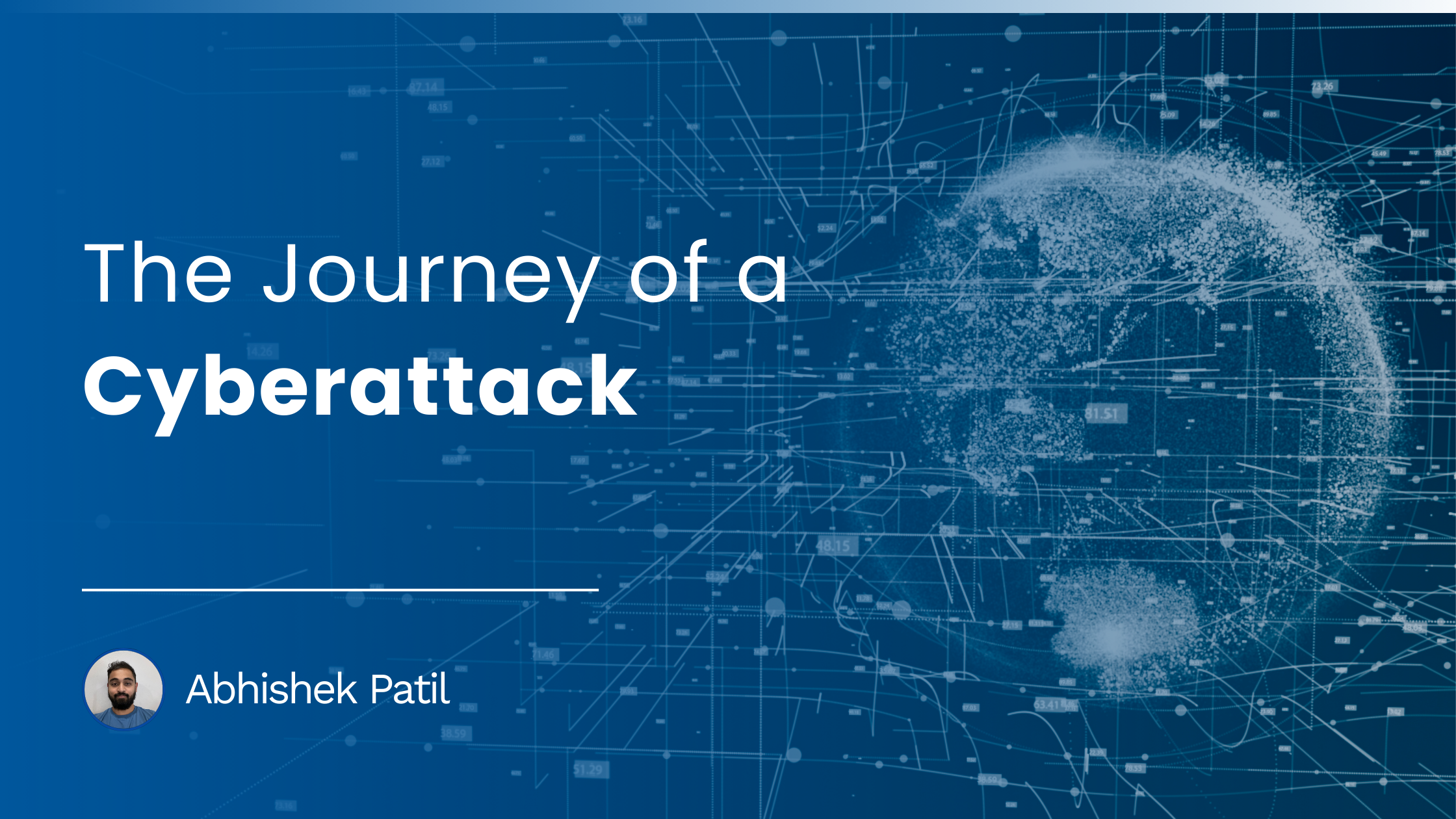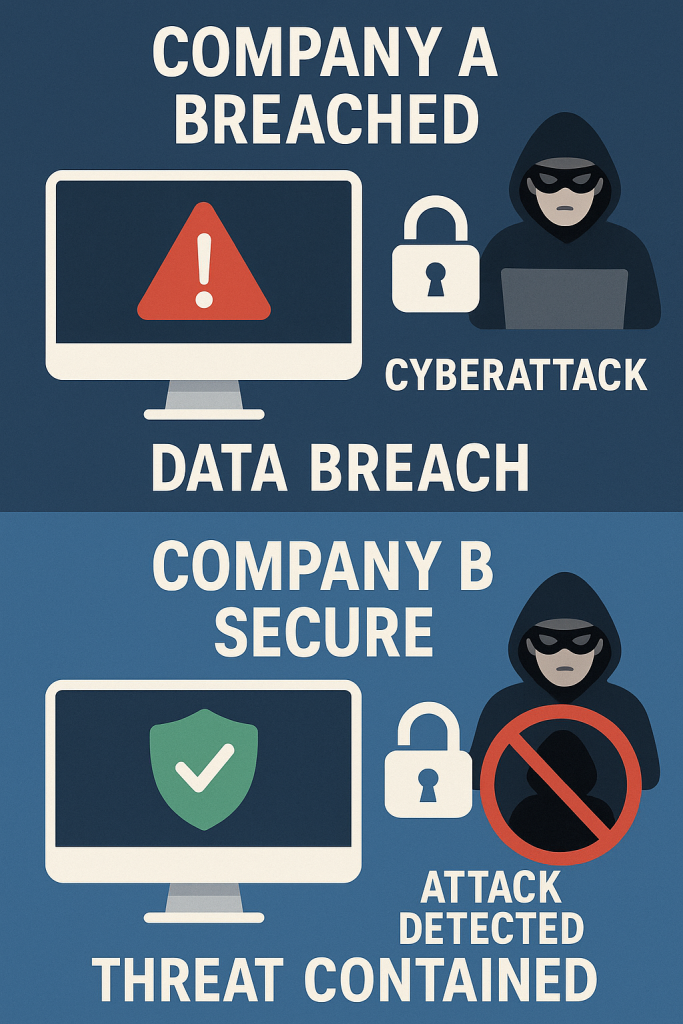Global cybersecurity reports all point to one clear message: Threats are rising, and data breaches are more expensive than ever. According to IBM, the worldwide average cost of a data breach in 2024 reached about $4.88 million, the highest on record. Cisco notes that attackers often enter through unpatched systems or stolen credentials. In 2024, the top initial vectors were vulnerable public-facing applications, compromised accounts, and phishing attacks.
Similarly, Google Cloud research warns that ransomware operations exploded in 2023, with a 75% jump in victims posted on data-leak sites compared to the previous year. In parallel, Microsoft reports that malicious phishing traffic roughly doubled over the last four years, underscoring how social engineering remains a favorite tool of hackers.
These trends set the stage for two contrasting stories: One mid-size firm that fell victim to a breach, and another that stopped an attack in its tracks. Let’s name the two Companies A and B respectively. We’re going to look at two different scenarios where Company A suffers a cyberattack and Company B was able to successfully stave off the attack.
Scenario 1: The Beginning of a Breach
It was an ordinary Monday when Company A, a mid-sized manufacturing firm, first felt the impact of a cyberattack. An accounting employee clicked a seemingly routine invoice link, but instead a hidden malware payload silently installed itself on their workstation. Within minutes the attackers had gained a foothold inside Company A’s network. In many real incidents, that initial phishing click is enough. Cisco notes that phishing and stolen credentials rank among the most common entry points for breaches. In this case, the downloaded malware collected the employee’s login credentials, granting the attackers access to Company A’s internal systems.
The main steps of the attack progression included:
- Initial Breach (Phishing): A spear-phishing email tricked an employee into running a malicious attachment. The malware established a remote shell in Company A’s network.
- Credential Theft: The trojan harvested valid user credentials. Using those stolen logins, the attackers logged into Company A’s on-premises network as if they were a trusted user.
- Privilege Escalation: Once inside, the attacker exploited an unpatched on-premises server to elevate privileges. Cisco Talos emphasizes that “older infrastructure,” and unpatched software are frequently targeted by attackers. Here a known vulnerability in a database server gave the attacker administrator rights.
- Lateral Movement: With admin access, the intruder moved laterally from machine to machine. Segmentation was insufficient, so the attacker could access multiple parts of the internal network.
- Data Exfiltration: Over the next few weeks, sensitive files — financial records, intellectual property, and customer data — were quietly copied to an external server.
- Ransomware Deployment: Finally, the attacker triggered a ransomware payload. Critical systems became encrypted overnight, and a ransom note demanded payment for the decryption keys.
When Company A’s IT team awoke to find servers locked and business operations stalled, the impact was immediate and severe. Production lines halted, customer orders couldn’t be processed, and external partners were notified of a breach. Recovery took months, where systems had to be rebuilt from clean backups, regulatory notifications sent, and forensic analysis conducted to make sure the intruder was fully removed. The disruption and reputational damage added to the financial hit, which is a fairly expected outcome in line with industry data.
IBM reports that the average breach cost is now nearly $4.88 million, and breaches involving cloud or hybrid environments can be even more expensive. For example, IBM notes that when sensitive data spans multiple environments, breach costs soar; public-cloud breaches averaged about $5.17 million.
Ways Company A Could Have Prevented the Breach:
- Employee Training and Awareness: Regular phishing simulations and security training would help staff recognize malicious emails. Cisco highlights that individual vigilance against social engineering is imperative.
- Multifactor Authentication (MFA): Forcing an additional login factor would have stopped the stolen credentials from working. Cisco recommends MFA and strict access controls as core defenses.
- Patching and Asset Management: Keeping software up to date would have closed the vulnerability used for privilege escalation. Talos experts stress that unpatched, aging infrastructure is “low-hanging fruit” for attackers.
- Network Segmentation: Dividing the network into isolated zones would limit lateral movement. Cisco advises segmenting high-value assets to contain breaches.
- Incident Response Planning and Automation: Having a tested incident response playbook — and automated monitoring — could shrink response time. IBM finds that organizations using security AI/automation save roughly $2.22 million in breach costs compared to others. In short, proactive detection tools and clear procedures can make the difference between days and months of recovery.
Scenario 2: A Thwarted Cyberattack Attempt
At Company B, another mid-sized company, a similar attack was attempted but security controls and quick action saved the day. One evening in late 2024, the security operations center (SOC) team noticed something odd. There were logs of multiple failed sign-in attempts to an administrator account. The firm had enforced MFA on all accounts, so none of those password attempts succeeded. Cisco Talos specifically recommends MFA to block attackers who get hold of credentials.
Almost simultaneously, an endpoint detection system on one workstation flagged a suspicious script execution. In a fraction of a second, the endpoint detection and response (EDR) quarantined the file before it could run. At the same time, a cloud-native monitoring service reported an unusual API call from the same user account. The company’s SIEM correlated these anomalies — strange logins, a blocked payload, and an odd cloud request — and threw a high-priority alert to the SOC team.
Here are some of the main actions that helped stop the attack.
- MFA: The attacker’s stolen password alone was useless. The extra login factor stopped an account takeover before it began.
- SIEM and Log Correlation: A security information and event management system tied together disparate alerts (failed logins, API anomalies) to give a unified incident picture. Real-time alerts cut detection time drastically.
- EDR: Advanced EDR software on the employee workstation caught the malicious payload immediately, isolating it before infection could spread.
- Cloud-Native Security Tools: Company B’s cloud environment was monitored by integrated services that flagged the abnormal API call. This bridge between cloud and on-prem detection provided a fuller view of the attack pattern.
- Network Segmentation: Because important servers were on a separate network segment, the intruder couldn’t jump from the workstation into sensitive infrastructure.
- Incident Response Team: With alerts in hand, the security team executed their playbook. They isolated the affected workstation, forced password resets on any at-risk accounts, and patched the vulnerability the attacker attempted to exploit. The team also worked with legal and communication teams early to manage any fallout.
In the end, no data was exfiltrated and no systems were lost. Company B continued business as usual. What took the SOC team minutes might have taken organizations months: IBM’s data shows the mean time to identify and contain a breach is around 258 days. In other words, the company’s quick response, which was hours instead of weeks, was exceptional. The security team documented the incident thoroughly, but ultimately the loss was negligible. Only a handful of workstation hours were lost, there was no customer impact, and no ransom was paid.
Defenses that made the difference: Multi-layered security and preparedness. The company’s blend of cloud-based alerts and on-prem tools ensured no blind spot. The enforced MFA and segmentation meant attackers were boxed in without options. Above all, automation and monitoring were crucial: security AI and automated correlation tools (IBM notes these can save millions in breach costs) caught the attack early. Thanks to these safeguards and a practiced IR team, a potentially serious breach was stopped cold.
Here’s What We Learned
- Security Costs are Increasing: The average breach now costs nearly $4.9 million, and expenses rise further if cloud assets are involved. Businesses should budget for robust security because a single incident can impose huge financial and reputational losses.
- Phishing and Weak Credentials Remain Top Risks: Common attack paths include compromised user accounts, phishing emails, and unpatched software. Protecting against those means employee training and strong authentication.
- Layered Defenses Pay Off: As expressed in scenario 2, combining MFA, endpoint protection, SIEM logging, and cloud monitoring can detect and block attackers early. Cisco experts recommend all of the above — plus network segmentation and incident response planning — as foundational defenses.
- Automate and Prepare: Automated detection, AI-driven monitoring, for example, can drastically cut breach lifetimes. IBM finds that organizations using security AI saved on average $2.22 million per breach. In practice, a well-practiced IR plan and rapid response capability are what turn a breach into a close call.
- Learn from Incidents: The stories above showcase how small mistakes like a missed patch or a clicked link can cascade into a crisis. Regularly review incidents and threat reports so your security strategy evolves.
Each year’s security reports drive the point home: attacks are inevitable, but their impact can be managed. By understanding how breaches happen and by investing in detection and response, businesses can avoid becoming another costly statistic.
Following Company B’s way of managing security sounds ideal, doesn’t it? Well, it’s not easy to achieve what it did, but our infosec professionals at SecPod know a shortcut: one that prevents cyberattacks altogether.
Want to know more about how you can protect your on-prem and cloud environments affordably and with ease? Contact us today.


